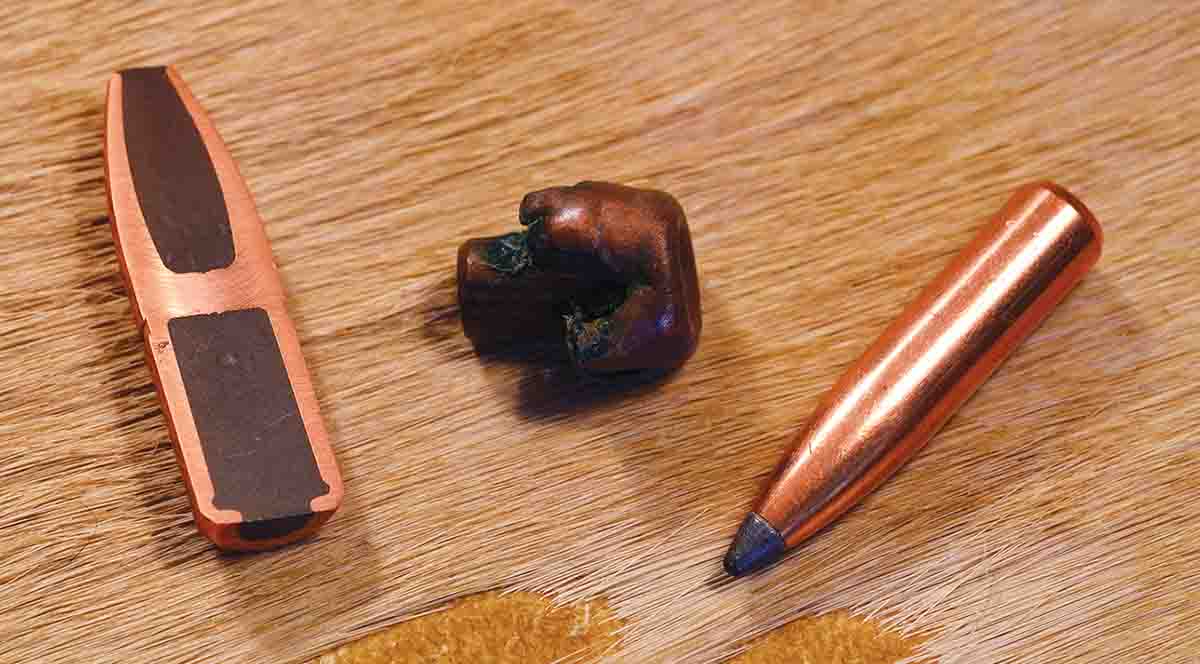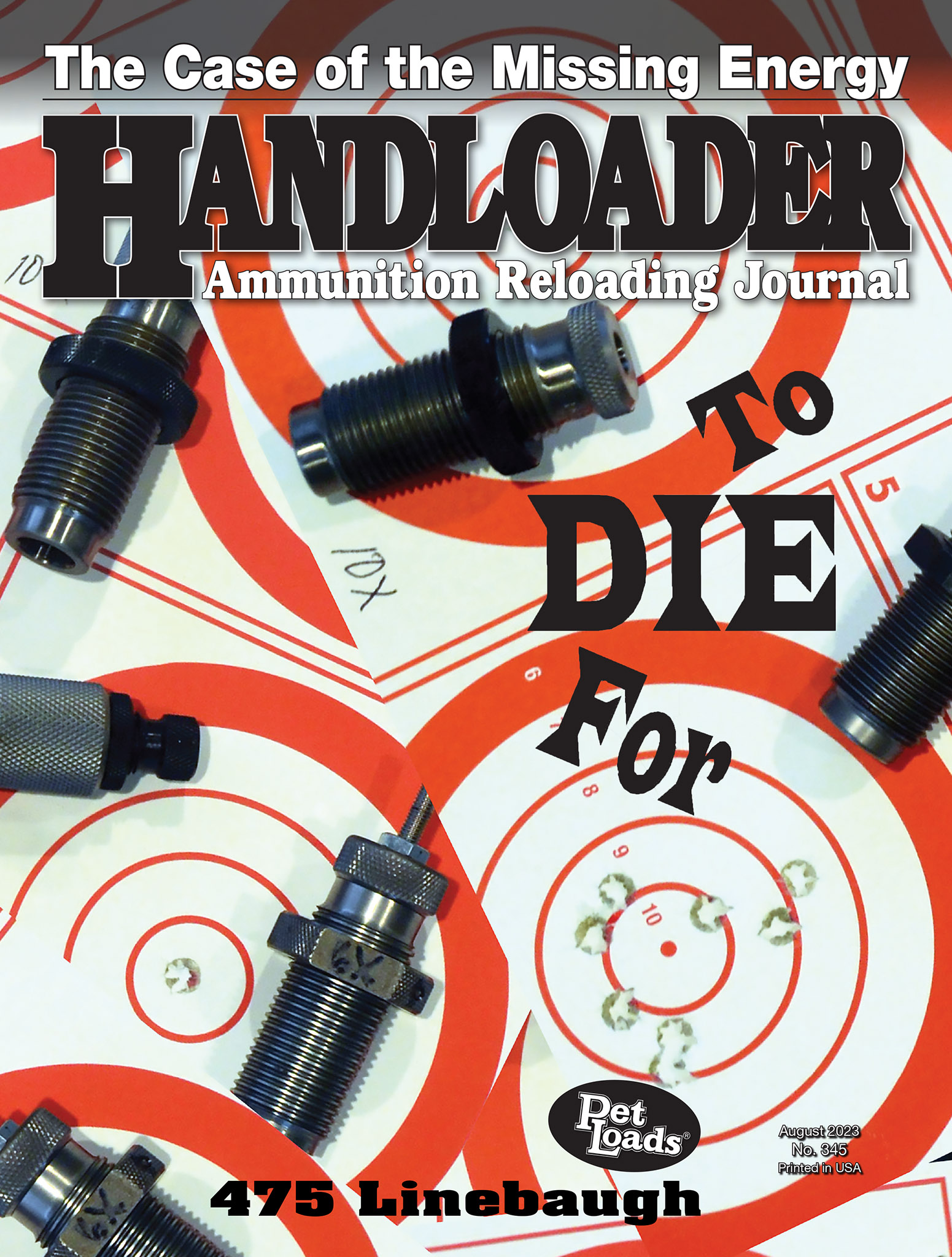In Range
Full Circle
column By: Terry Wieland | August, 23

In terms of game bullets (as opposed to match, much of the credit for this is due to four people: John Nosler, father of the Nosler Partition; Bill Steigers, inventor of the Bitterroot bonded bullets; and a decade or two later, by Lee Reed at Swift and Jack Carter, inventor of the Trophy Bonded Bear Claw.
In the sense that there is nothing new under the sun, we could go all the way back to the first jacketed hunting bullets, developed after 1900 in response to the increased velocities of smokeless powders, to explain all this, but we can skip that.
Essentially, increased velocities demanded tougher bullets, but when the real velocity revolution began in the 1950s, hunters found that bullets that held together reliably at 2,000 feet per second (fps) would fly apart on impact at 3,000 fps. A full metal jacket (FMJ), such as the military used, certainly held together, but it skipped right on through, not expanding at all.
To reach an animal’s vitals, you need penetration, and to get penetration, you need the bullet to hold together and retain weight. At the same time, it must expand in order to inflict a devastating wound channel. Given the wide range of velocities, differences in animal size, and the various parts of the animal that might be struck, it would seem that creating a bullet that performed well in all circumstances was an impossible task.
Well, almost.
After experiencing bullet failure hunting moose in, if memory serves, 1948 or ‘49, John Nosler returned home, turned his inventive mind to the problem, and came up with the Nosler Partition. This was America’s first genuine premium hunting bullet, and remained number one for the best part of 40 years. It has a lead core front and back, with a partition in the center to stop expansion. This idea was already in use in Europe, with the RWS “H-mantle” bullet, but the Nosler Partition made it widely available in America, in an ever-increasing variety of calibers and bullet weights. The Nosler Partition cost twice as much as a conventional bullet, but it was well worth it.
Other inventors tried different approaches. Bill Steigers, of the Bitterroot Bullet Co., bonded lead cores to copper alloy jackets, ensuring that while the bullet expanded, the core did not separate from the jacket. This is a lot easier said than done, and various methods were tried. To this day, I don’t think anyone knows for sure how Steigers did it. Most believe it was some sort of bonding agent – epoxy was often mentioned – but simple glue doesn’t do the trick, otherwise everyone would do it.
Excellent as they were, the problem with the Bitterroot was that Steigers produced them by hand and waiting lists stretched into years, and they became, for all practical purposes, unobtainable.
Jack Carter, a big-game hunter and retired IBM executive from Houston, was a devoted Bitterroot user. In the 1970s, hunting elephant in Kenya, he had a large-bore solid fail – it bent in half on impact with bone – and he returned to the U.S. determined to make a better one. As well, finding Bitterroots back-ordered and waiting lists measured in years, he added a bonded core expanding bullet to his to-do list.
Jack used pure lead inside pure copper jackets, because alloying either metal makes them brittle. In their pure form, they are as malleable as chewing gum – well, almost – and mushroom beautifully. He was assisted in his work by two men: Finn Aagaard, a Kenya professional hunter who had emigrated to the U.S., and was writing for the NRA, and Jim Riley, a Ford engineer who had a custom handloading business. Finn did much of the penetration testing, while Jim tested for accuracy and determined ballistic coefficients.
I was introduced to them all in 1989, and became involved in some of the testing, as well as writing about their work.
Jack called his expanding bullet the Trophy Bonded Bear Claw, and the solid was the Sledgehammer. He produced them in a small, converted garage in Houston, in calibers ranging from .270 to .500.
His main rival was Lee Reed’s Swift Bullet Co. and its A-Frame bullet, which combined a hefty partition (although he wasn’t allowed to call it that, for copyright reasons) with a bonded core. Please don’t ask me which was better. In my opinion, you couldn’t go wrong with either one.
Jack’s was essentially a one-man operation, and since he wasn’t getting any younger and, as a lifelong diehard smoker, his health was not good, so by the early 1990s, he wanted to sell his company. The buyer was Tommy Friedkin, a wealthy Texan big-game hunter and admirer of the Bear Claw. Friedkin owned, among other things, an airline, a chain of Toyota dealerships, and two African safari companies. Robin Hurt’s Tanzania Game Trackers, and in Botswana, Safari South, which employed such luminaries as Tony Henley, Lionel Palmer and Harry Selby.
I believe Friedkin’s initial idea was to combine a bullet company with a riflemaker and other related outfits. If so, it never came to fruition. Around 1998, he sold Trophy Bonded and the rights to the bullet design to Federal Cartridge, which was sorely in need of a premium game bullet to put up against the latest offerings from Winchester and Remington. At that time, Federal loaded Nosler Partitions and Swift A-Frames in its premium ammunition, at substantial extra money, but owning Trophy Bonded would give it complete control.
In 1990, in one of the great strokes of luck of my admittedly lucky professional life, Jack Carter called and asked if I’d like to go to Africa again, this time to test new Bear Claws on safari with, first, Robin Hurt in Tanzania, and then to Botswana to hunt with Tony Henley. We were to hunt Cape buffalo in both places and assorted plains game.
Also along was Finn Aagaard. For the occasion, Jack responded to my whining by creating a 115-grain .257 Bear Claw for my spiffy custom Weatherby, a 100-grain .243 for himself, and a 140-grain .264 for Finn to use in his 6.5x55 Swedish. Jack had contended up until then that there was an insufficient market for expensive premium game bullets in small calibers. Within two years, those three had become his best-selling products. Alas, under Federal, they were the first to go.
There is much more to the story of the evolution of premium game bullets since 1990. Bitterroot is long gone, but Swift is still around, and the A-Frame is as good as ever, and Nosler, bless them, continues to produce Partitions in the widest range of calibers, weights and configurations of any company. Also, where once it was the most expensive production bullet, it is now cheaper than many of its premium rivals.
No one individual or company deserves all the credit for the situation in which we now find ourselves, which is that the average hunting bullet today is a huge improvement over the average hunting bullet we could buy in the 1970s. They are more accurate, expand when they are supposed to, and hold together more dependably.
One thing we can say for sure is that all of this did not happen because of the initiative and far-sightedness of the big ammunition companies, Federal being the exception. It was John Nosler, Bill Steigers, Lee Reed and Jack Carter who had the vision, did the work, and forced the change. The result is better for everybody.
Oddly enough, I should add that, after all these years, all the work testing bullets, and two trips to Africa specifically for that purpose, if I were loading for a trip where bullet performance was vital, I would turn to the Nosler Partition for anything up to .358, and the Swift A-Frame for anything bigger.


